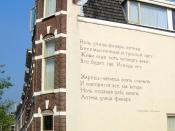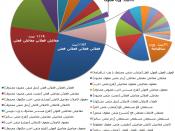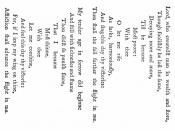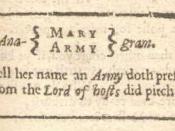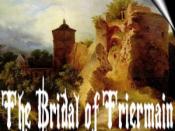Reading Poetry Responsively:Begin reading poetry naturally, like listening to a songRead it repeatedly without analyzingGive yourself a chance to respond to itStart by listening for pleasureThen read poem aloud, before reading it silentlyPay attention to punctuation and only stop when you see itAlways pay attention to the titleA. The Secretary ChantPoem's message is secretary feels "dehumanized" by her jobSounds mechanicalUses flat statementsPoem is a social commentary for womenHint of humorPuts "w" in front of once for alliterationB. Those Winter SundaysThink about titleTry to associate your emotions and memories about winter SundaysNo masculine pronoun used, making it gender neutralAsk questions about tone, words, syntax, etc.
To answer questions, we first have to ask them⨠The Pleasure of Words:Poetry is an ancient art, discovered when language was usedTribal ceremonies of primitive cultures incorporated rhythmic patterns of words into rituals.
Chants depicted important aspects of their livesThe Greeks made poetry part of religionPoetry has always been associated with what people think matters most to themPoetry is part of our world; advertising, songs, etc.
Poetry attempts to stir the imagination through careful syntaxWord play is very important in poetryThe expression of an idea is as important as the idea itselfPoetry should invoke pleasure or some sort of emotionDoggerel- term used for lines whose subject is unoriginal and whose rhythm and sounds are boringEdwin Arlington Robinson stated "poetry has two outstanding characteristics. One is that it is indefinable. The other is that it is eventually unmistakable."Emphasizes the effects of a poem on the readerA Sample Close Reading:An Annotated Version of "Oh, Oh"close readings, line by line, word by word, reveal more about the poemwhat happens in the poem?What are the central ideas?How do the words, sounds, and images contribute to meaning?What is the overall tone?How is it put together?Poem shifts reader's expectationsHumorous poem, indicated by titleParaphrase- a prose restatement of central ideas of poemParaphrase can help achieve a better understanding of poemIt misses certain aspects of the poemPoetry is meant to move and exciteIt is best to relax and read rather than worry about analyzingPoems are read for emotional and intellectual discoveriesThe ideas are important, but more value comes from the wordsA Sample Student Analysis:Tossing Metaphors Together in "Catch"Important to stay on track and discuss only what is assignedTitle reflects central metaphorPaper centered around 4 key words in the poem: "attitudes, latitudes, interludes, altitudes"Important to have smooth transitions"The Fish" by Elizabeth BishopLines 10-40 provide most vivid details of the fishprovide anatomical details about the fishcolorsshapestexturesThe descriptions are effective because they connect the reader to the story - describe the fish so the reader gets a good sense of the speaker's POVFish is not just a weak victimcharacterized as an "old veteran""from his lower lip...grim, wet, and weapon-like, hung five old pieces of fish-line""like medals with their ribbons"The obvious experience and valor made the speaker feel like it wasn't his place to take the fish's life - causing him to let it go.
speaker- voice used by the author- not exactly like narrator in fiction"A Study of Reading Habits" by Philip LarkinLarkin distances himself from the speakerIn the latter half, he contradicts speaker's previous assertionsLost interest in reading as adult (2nd half)Doesn't fully understand reading anymore - identifies self with less important characters instead of main antagonists or protagonistsSpeaker mistakably thinks that only goal of reading is to serve as a positive route of escape from lifewords are never chosen on accident- so limited that they are specifically chosen to give us "feels" of surroundingsverse- lines composed in a measured rhythmical pattern"Mountain Graveyard" by Robert Morganuses anagrams- words made from the letters of other wordsanagrams suggest opinions on deathin honor of the birthday of the poet of "Slow Owls" - an anagramtitle implies that list of rearranged words has higher meaningtheme- central idea"l)a" by E.E.Cummingslyric- a brief poem that expresses the emotions of a speakercan be about any subject - often about love or deathhave musical qualities"Western Wind" by Anonymousshort about speaker's want to have Western Wind that allows them to see lovertells a feeling, not a storynarrative poem- poem that tells a storyepic- long narrative poem"Nighttime Fires" by Regina Barrecanarrative poemcould easily have been a short story if author care to elaborateShort stories are now much more popular than narrative poems"Introduction to Poetry" by Billy Collinsauthor promotes letting the rhythm of the poem flow through reader, but all reader wants to do is "beat it with a hose" to derive meaningThe mood begins to be very upset at line 12Poetry in Popular Formsgreeting cards are most widely-read of today's poetryquite popular in today's societyallow us to not have to make our own poetry, but to still be considered "creative" due to cards' varietynot complex - made for layman to be able to easily absorbrely on unoriginal cliches- overused phrasesdraw out stock responses- predictable and conventional reactionsSentimentality- makes reader feel more emotion towards something (e.g. a greeting card) than the thing deservessongs are most widely-heardhold many of the same qualities poems hold"You're Missing" by Bruce Springsteenuses repetition to invoke feeling of lossseparated into proper stanzas"It's the Law: a Rap Poem" by S.Pearl Sharprhymesrepetitionhas central theme of difference between "laws" and "rules"Perspective"On Hard Poetry" by Robert Francismany varieties on mood and "softness" of poems"hard" poems always have some difficulty - either in writing or in readingideal hard poem makes reader struggle some, but not so much as to deter them from finishingBibliography:Meyer, Michael. Poetry an Introduction. Fifth Edition.
